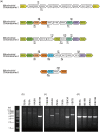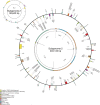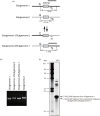Whole Mitochondrial Genome Sequencing and Re-Examination of a Cytoplasmic Male Sterility-Associated Gene in Boro-Taichung-Type Cytoplasmic Male Sterile Rice
- PMID: 27414645
- PMCID: PMC4944960
- DOI: 10.1371/journal.pone.0159379
Whole Mitochondrial Genome Sequencing and Re-Examination of a Cytoplasmic Male Sterility-Associated Gene in Boro-Taichung-Type Cytoplasmic Male Sterile Rice
Abstract
Nuclear genome substitutions between subspecies can lead to cytoplasmic male sterility (CMS) through incompatibility between nuclear and mitochondrial genomes. Boro-Taichung (BT)-type CMS rice was obtained by substituting the nuclear genome of Oryza sativa subsp. indica cultivar Chinsurah Boro II with that of Oryza sativa subsp. japonica cultivar Taichung 65. In BT-type CMS rice, the mitochondrial gene orf79 is associated with male sterility. A complete sequence of the Boro-type mitochondrial genome responsible for BT-type CMS has not been determined to date. Here, we used pyrosequencing to construct the Boro-type mitochondrial genome. The contiguous sequences were assembled into five circular DNA molecules, four of which could be connected into a single circle. The two resulting subgenomic circles were unable to form a reliable master circle, as recombination between them was scarcely detected. We also found an unequal abundance of DNA molecules for the two loci of atp6. These results indicate the presence of multi-partite DNA molecules in the Boro-type mitochondrial genome. Expression patterns were investigated for Boro-type mitochondria-specific orfs, which were not found in the mitochondria from the standard japonica cultivar Nipponbare. Restorer of fertility 1 (RF1)-dependent RNA processing has been observed in orf79-containing RNA but was not detected in other Boro-type mitochondria-specific orfs, supporting the conclusion that orf79 is a unique CMS-associated gene in Boro-type mitochondria.
Conflict of interest statement
Figures




References
-
- Schnable PS, Wise RP. The molecular basis of cytoplasmic male sterility and fertility restoration. Trends Plant Sci. 1998; 3: 175–180. 10.1016/S1360-1385(98)01235-7 - DOI
MeSH terms
LinkOut - more resources
Full Text Sources
Other Literature Sources
Molecular Biology Databases

